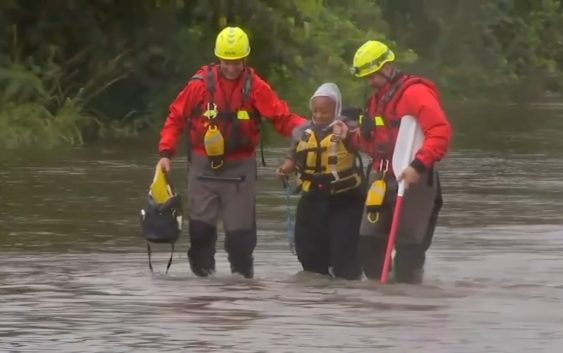- Long-term closures begin on I-10 Katy Freeway to elevate road, prevent flooding
- Texas firefighters helping battle California wildfires
- Western NC teams helping both hurricane and wildfire victims
- New wildfire warnings issued and more power is shut off as winds rise in Southern California
- In wake of wildfires, Spurs' Chris Paul, Victor Wembanyama give JJ Redick's sons their game-worn jerseys
Amid pandemic, NC Emergency Management adjusts playbook for hurricane season

The dozens of unoccupied stations inside the Situation Room at North Carolina’s Emergency Operations instead reflect the new reality of remote management: public safety, transportation, health officials and National Guard officers coordinating the state’s response to global pandemic that’s killed more than 110,000 Americans.
Now, a new front is opening against a familiar opponent, but fighting severe weather this year will be anything but routine.
“We’ve always known that Hurricane Season 2020 was over the hill and on the horizon, and now it’s upon us,” Mike Sprayberry, North Carolina’s Directory of Emergency Management, tells ABC11 in a masked in-person interview. “I believe that with proper planning and proper management, we’ll be able to take the resources to fight the enemy, which is the hurricane.”
Sprayberry, a military veteran, is also a veteran of leading the state’s response to severe weather that has crippled the Tar Heel State, including the back-to-back-to-back punches of Hurricanes Matthew (2016), Florence (2018) and Dorian (2019).
“We had 35-40 states that provided us with assistance during Florence,” Sprayberry said. “Everything from nurses, swift water rescue teams, urban search and rescue task forces.”
Because of the new coronavirus, Sprayberry is warning other states will be unable to provide those resources again.
“We’re pretty much going to have to be aware that we’re not going to be able to county on assets from other states like we would have in the past,” he said. “We’ll still be able to get some of it but not like we would have before.”
Indeed, even resources from the western part of the state will be hard to come by as personal protective equipment (PPE), remains a premium for hospitals and clinics across all of North Carolina’s 100 counties.
While trying to save people and property in a hurricane, emergency officials are also cognizant of saving lives by preventing the spread of COVID-19.
“We’ll want to have enough face coverings and things like that so when our resources are out on the field they’ll have those coverings. Let’s be ready. Don’t let your guard down.”
The consensus among all high ranking officials is that preparing and offering evacuation shelters will be the most difficult for this storm season, as the traditional playbook calls for packing evacuees into gymnasiums and community centers. Amid the pandemic, emergency managers are largely increasing the roster of available spaces and recruiting more staff to implement social distancing measures. There’s also going to be an expanded cleaning and sanitizing regiment.
Still, several logistical challenges remain, including how to disperse food, administer temperature checks, and how to isolate individuals who test positive for the disease.
“Typically we’ve relied on volunteers from the American Red Cross and partners from Division of Social Services and a lot of those volunteers are what you would classify as high risk population,” Sprayberry said. “What we’re encouraging people to do is to build their own evacuation plan so when they evacuate they don’t plan on going to a shelter, but plan on going to friends or family they may know. Try to think about who are you going to go stay with rather than going to a shelter.”
Officials this year are also encouraging families to add items like masks and hand sanitizer into their emergency kits.
“It really to me brings it home that what we’re doing is so serious,” the director said. “By paying attention to how many (COVID-19 patients) are intubated and in hospitals, people dying, it prevents me from having a sense of complacency.”
Copyright © 2020 WTVD-TV. All Rights Reserved.